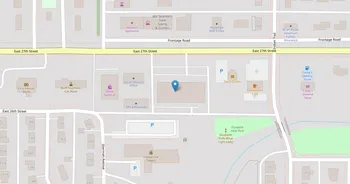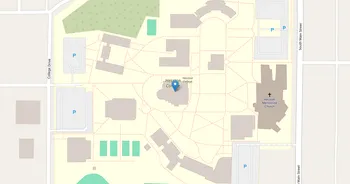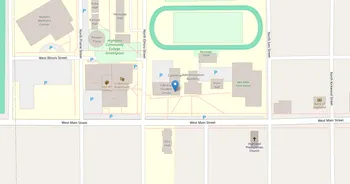Haskell Indian Nations University (HINU) : Overview, Courses, Scholarships & Rankings
About Haskell Indian Nations University
Known as one of the few intertribal universities in the country, Haskell Indian Nations University centers Native voices in every classroom. Courses often weave community knowledge, land stewardship, policy thinking, and creative expression, with small-group attention and a practical, hands-on approach. Faculty have a reputation for mentoring closely and grounding learning in real issues facing tribal communities. The atmosphere feels tight-knit and intertribal, with respect for ceremony and a healthy dose of humor.
Campus life balances tradition and day-to-day student needs. You'll find a library, student center, cultural spaces, tutoring and advising, wellness care, and places to move, play, and compete. Regular social gatherings, powwow gatherings, arts events, and service projects give the campus its heartbeat. Nearby wetlands and trails invite quiet time or fieldwork. Career prep leans on connections with tribal governments, federal partners, nonprofits, and regional employers. And the Lawrence scene adds coffee shops, live music, internships, and a welcoming college-town vibe.
Key Institutional Details
Contact & Profile
Academic & Institutional
Academic Programs & Fields of Study
Haskell Indian Nations University (HINU) offers 13 degree programs across 12 major academic fields, graduating approximately 159 students annually. The most popular fields by graduate volume are Liberal Arts (1 programs, 55 graduates), Business (1 programs, 26 graduates), Cultural Studies (1 programs, 22 graduates), Interdisciplinary (1 programs, 14 graduates) and Natural Resources (1 programs, 8 graduates). Explore program details, award levels, and graduate demographics below.
Liberal Arts (1 programs, 55 graduates)
Liberal Arts Education, General Studies and Humanities
| Program Name | Graduates | Gender Distribution | Award Levels | CIP Code |
|---|---|---|---|---|
| General Studies | 55 |
|
Associate's
|
24.0102 |
Business (1 programs, 26 graduates)
Business Administration, Marketing and Entrepreneurship
| Program Name | Graduates | Gender Distribution | Award Levels | CIP Code |
|---|---|---|---|---|
| Business Administration and Management | 26 |
|
Bachelor's
|
52.0201 |
Cultural Studies (1 programs, 22 graduates)
Cultural Anthropology, Ethnic Studies and Social Group Research
| Program Name | Graduates | Gender Distribution | Award Levels | CIP Code |
|---|---|---|---|---|
| American Indian and Native American Studies | 22 |
|
Bachelor's
|
05.0202 |
Interdisciplinary (1 programs, 14 graduates)
Cross-Disciplinary Studies and Integrated Research Programs
| Program Name | Graduates | Gender Distribution | Award Levels | CIP Code |
|---|---|---|---|---|
| Natural Sciences | 14 |
|
Associate's
|
30.1801 |
Natural Resources (1 programs, 8 graduates)
Environmental Science and Natural Resource Management
| Program Name | Graduates | Gender Distribution | Award Levels | CIP Code |
|---|---|---|---|---|
| Environmental Science | 8 |
|
Bachelor's
|
03.0104 |
Education (1 programs, 7 graduates)
Educational Sciences, Teaching Methods and Pedagogy
| Program Name | Graduates | Gender Distribution | Award Levels | CIP Code |
|---|---|---|---|---|
| Elementary Education | 7 |
|
Associate's
Bachelor's
|
13.1202 |
Kinesiology (2 programs, 7 graduates)
Exercise Science, Sports Medicine and Physical Recreation
| Program Name | Graduates | Gender Distribution | Award Levels | CIP Code |
|---|---|---|---|---|
| Sports, Kinesiology, and Physical Education | 6 |
|
Associate's
|
31.0501 |
| Sport and Fitness Management | 1 |
|
Associate's
|
31.0504 |
Public Services (1 programs, 7 graduates)
Public Administration, Social Work and Community Services
| Program Name | Graduates | Gender Distribution | Award Levels | CIP Code |
|---|---|---|---|---|
| Social Work | 7 |
|
Associate's
|
44.0701 |
Communication (1 programs, 5 graduates)
Media Communications, Journalism and Public Relations
| Program Name | Graduates | Gender Distribution | Award Levels | CIP Code |
|---|---|---|---|---|
| Speech Communication and Rhetoric | 5 |
|
Associate's
|
09.0101 |
Health (1 programs, 5 graduates)
Healthcare Professions, Medical Sciences and Clinical Practice
| Program Name | Graduates | Gender Distribution | Award Levels | CIP Code |
|---|---|---|---|---|
| Community Health and Preventive Medicine | 5 |
|
Associate's
|
51.2208 |
Admission Requirements & Test Scores
Comprehensive overview of admission criteria, standardized test score ranges, and application requirements for prospective students at Haskell Indian Nations University (HINU).
Application Requirements
Data based on IPEDS for 2022-2023 academic year. Test score ranges represent the middle 50% of admitted students (25th-75th percentile). Requirements may vary by program.
Tuition, Fees & Estimated Costs
Overview of tuition rates, housing, and other annual education expenses for undergraduate and graduate students
Financial Aid & Student Support
Summary of scholarships, grants, student loans, and financial aid statistics for undergraduate students
Student Success Metrics
Graduation rates and post-graduation earnings to help assess student outcomes and long-term value of education.
Loan Burden & Repayment Outcomes
Breakdown of loan repayment rates and student debt levels by income and dependency status.
Frequently Asked Questions
Find answers to the most common questions about Haskell Indian Nations University (HINU)
How much does it cost to attend Haskell Indian Nations University (HINU)?
The annual tuition at Haskell Indian Nations University (HINU) is $600 for in-state students. When including room and board, books, and other expenses, the total estimated cost is approximately $9,010 for in-state students. Additional costs include room and board $1,190 (on) / $12,717 (off) and books and supplies $1,600.
Data based on IPEDS program completions for 2022-2023 academic year. Tuition and cost estimates are approximate and may not include all fees, personal expenses, or transportation costs.
What academic programs and degree levels does Haskell Indian Nations University offer?
Haskell Indian Nations University (HINU) offers 13 academic programs across 12 major fields of study, with available degree levels: Associate's, Bachelor's, Residency.
Most popular program areas include:
- Liberal Arts Education, General Studies and Humanities (1 programs)
- Business Administration, Marketing and Entrepreneurship (1 programs)
- Cultural Anthropology, Ethnic Studies and Social Group Research (1 programs)
- Cross-Disciplinary Studies and Integrated Research Programs (1 programs)
- Environmental Science and Natural Resource Management (1 programs)
Data based on IPEDS program completions for 2023-2024 academic year. Numbers reflect programs where students graduated, not all offered programs.
What is the acceptance rate for Haskell Indian Nations University?
Haskell Indian Nations University (HINU) has an 88.3% acceptance rate and a 75.6% yield rate, making it moderately selective.
Admission statistics breakdown:
- Total applicants: 334
- Students admitted: 295
- Students enrolled: 223
Data based on IPEDS for 2022-2023 academic year. Admission statistics may vary by program and application cycle.
What financial aid and scholarships are available at Haskell Indian Nations University?
Haskell Indian Nations University (HINU) provides financial aid to 27% of first-time, full-time students, with average grants of $5,199 and average loans of $0.
Average financial aid amounts by type:
- Pell grants: $5,693
The university supports 153 students with grants and 0 students with loans annually.
Data based on IPEDS for 2022-2023 academic year. Financial aid amounts and percentages may vary by program, enrollment status, and individual circumstances.
What is the average salary for Haskell Indian Nations University graduates?
Haskell Indian Nations University (HINU) graduates earn a median salary of $28,425 after 6 years and $37,043 after 10 years.
The salary range 10 years after graduation spans from $19,832 (25th percentile) to $51,759 (75th percentile), with top earners reaching $54,400 (90th percentile).
Data based on IPEDS for 2022-2023 academic year. Salary data reflects graduates who received federal financial aid (approximately 60% of all graduates). Actual earnings may vary significantly based on program, location, and individual circumstances.
Related Universities




Found something useful? Help others discover it too! Share with friends, on social media, or save for later - every share helps someone find the information they need.